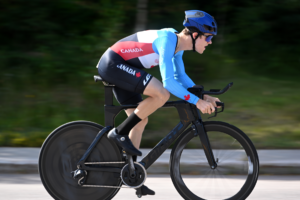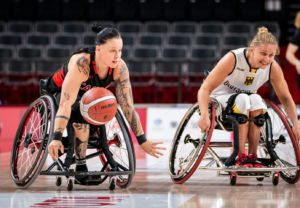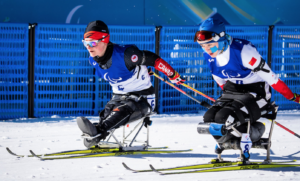With approximately 75% of Canadian youth involved in organized youth sport, it’s uniquely positioned to promote mothers’ mental health and wellbeing. Learn more about how youth sport administrators, program leaders and families can create positive experiences and outcomes for youth sport moms in the SIRCuit.
Women hockey players in Quebec often report needing to travel long distances or move away from home to play in women-only leagues. When girls or women’s teams aren’t available at the desired competitive level, many turn to boys or men’s teams. New research shows that a lack of access to girls and women’s hockey programs is behind many players’ decisions to leave the sport. Discover creative strategies to engage girls and women in hockey in this SIRC blog.
Para sport has grown substantially in the past decades with increases in athlete participation as well as training intensities and sport performance (Patricios & Webborn, 2021; Fagher et coll., 2016). Yet, there is still limited research to help inform practice, especially concerning sport physiology and health in Para athletes (Gee et coll., 2021).
Recently, more dedicated research around Para sport training has improved. However, some aspects of health and wellbeing are not well understood, including how fatigue and recovery is managed, despite high incidences of injuries and illness among elite Para athletes (Harrington et coll., 2021; Fagher et coll., 2022a).
This blog shares findings from our research, which explored how Para sport practitioners manage recovery with their athletes. We interviewed experienced sport practitioners working with elite Para athletes across North America regarding the challenges and successes they had experienced with their athletes. We chose to interview a variety of professionals to ensure a balanced perspective, including coaches, physiologists, physicians, dieticians, rehabilitative therapists and a mental performance trainer.
Our interviews revealed clear themes about athlete recovery in Para sport, which are highlighted below:
1. Prioritize the simple concepts
Practitioners all shared the perspective that ensuring quality rest and proper nutrition are key to keeping athletes healthy and prepared. They emphasized that if athletes were rested and ate well, adaptations from training improved. This idea is not unique to Para athletes, but practitioners discussed the ways in which some Para athletes struggle to get good rest and nutrition.
For instance, some athletes with visual impairment have altered responses to light which may impact their sleep cycles. Some athletes might have sleep disturbances because of muscle spasms or chronic pain. Recent research looked at sleep habits in a large group of Swedish elite Para athletes and found that 60% reported sleeping 7 hours a night or less (Fagher et coll., 2022b). Further, given differences in digestion and appetite, particularly in athletes with spinal cord injuries, practitioners suggested focusing on the basics of simply eating enough.
Thus, if working with Para athletes of any level, remember to ask them about sleep and nutrition, and provide support accordingly.
2. Get to know the whole athlete
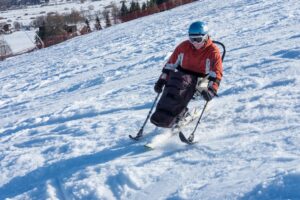 Many sport practitioners highlighted the importance of establishing quality relationships with the Para athletes with whom they worked. They emphasized that using self-report tools (for example, questionnaires or single questions where the athlete can rate their feelings or state of well-being) improved decision-making about how to adjust training and determine recovery needs.
Many sport practitioners highlighted the importance of establishing quality relationships with the Para athletes with whom they worked. They emphasized that using self-report tools (for example, questionnaires or single questions where the athlete can rate their feelings or state of well-being) improved decision-making about how to adjust training and determine recovery needs.
Beyond this, practitioners spoke about the importance of listening to and learning from an athlete’s lived experience, to get to know them as a person. Practitioners noted that spending time building relationships with Para athletes also helped to reduce unnecessary assumptions about disability, ultimately improving performance goals and maintaining better overall athlete health. The experts we interviewed stressed how a shift in expertise is required when working with Para athletes, allowing for more guidance from the athlete, trusting their judgment and knowledge of their body.
When working with Para athletes, remember that time, effort, and intimacy are required to appropriately understand each individual’s history with both their sport and disability.
3. Recognize diversity of experiences
The diversity of experiences among Para athlete populations is greater than mainstream athletes for a few reasons. First, there are a variety of different impairment types, as well as diversity within each impairment type. Second, each Para athlete has a unique individual lived experience, with both sport and disability. For example, athletes who have acquired an impairment later in life will have a different experience than those who experience a congenital impairment. We can consider the duration of time for which an athlete has lived with their impairment as their “impairment age.” This idea of impairment age matters to how you work and plan recovery in Para athletes. Some athletes might be navigating a newly changed body as well as adjustments in their daily lifestyle, while some Para athletes have significant years of dedicated training and therefore have a better understanding of training and recovery principles.
4. Think about musculoskeletal factors
The sport practitioners we interviewed all highlighted that muscle mass (amount of muscle), muscular imbalances (for example, different muscle function in one arm compared to the other), and muscle spasticity (increased muscle tone or stiffness) all influenced decision making for Para athletes. Muscle mass is an important consideration specifically with regard to athletes with high-lesion spinal cord injuries who may be recruiting all of their available functional muscle mass to meet activity demands. Understanding this, practitioners realized that longer rest intervals within training or between sessions may be needed to allow ample recovery time. Similarly, understanding muscle mass availability for each athlete is essential for proper programming of a training session, where less muscle mass may demand longer rest between work bouts and modification to the overall training session duration or number of sets, reps, or intervals completed.
Practitioners also highlighted that prescribing intensity of work and progression of training should be done carefully to avoid overtaxing the working muscles (especially in athletes who have smaller amounts of functional muscle). For athletes experiencing spasticity, increased muscle tone and stiffness can be exacerbated post-exercise, altering the rate of recovery post-exercise. When working with Para athletes, adding regular self-care strategies like massage and stretching into their training regimen to account for these musculoskeletal factors can be paramount to the quality and time duration of recovery.
5. Consider their activities of daily living
Lastly, sport practitioners discussed additional physical and mental stresses that many Para athletes accumulate in their daily lives outside of training, especially when more effort is required to navigate environments with reduced accessibility. This is particularly important for athletes with less functional muscle mass, where activities of daily living simply require more time, planning and overall energy. This cumulatively impacts how much true rest an athlete can get, especially when combined with training, therefore imposing greater total stress which can lead to chronic fatigue or risk of overuse injuries.
Injury prevention is critical since sport injuries can be especially detrimental among Para athletes, impacting their ability to train and making daily activities more challenging (Thompson & Vanlandewijck, 2021). One practitioner summarized by saying that the overall training program should include daily living stress as a factor in the overall training load. Working with athletes to explore strategies that reduce daily living stress is important to enhance recovery and preparedness to train and compete.
Concluding thoughts
We hope we have illuminated important aspects to consider when working with Para athletes. Overall, making sure to support athletes in their non-training hours will have positive results in training and competition. Given the unique lived experience that each athlete has, remember to listen to them and make decisions collectively based on their feedback. Health and training concerns among Para athletes vary, but regularly monitoring athlete health can help understand individual needs and prevent injury or illness (Fagher et coll., 2022c). Finally, ensuring that the basics of adequate sleep and nutrition are addressed is fundamental to preparing athletes to train and compete.
Exercise has many beneficial effects on the heart. Regular exercise reduces body weight, blood pressure, improves muscular function and strength of the heart and improves the body’s ability to take in and use oxygen. Research shows that adults should engage in at least 30 minutes of modest activity every day for heart health benefits. Modest activity may include a brisk walk, swimming and cycling.
Research shows that physical activity can improve academic performance in children. In addition, engaging in physical activity can improve attention and cognition. It is recommended that teachers provide students with physical activity breaks and that physical activity is integrated into the curriculum.
Highlights
- The Canadian Paralympic Committee and Own the Podium identified the creation of an “Athlete Transfer System” as a way to broaden Para athlete development pathways
- Athlete transfer is when an athlete switches sports or takes on an additional sport
- Currently, athlete transfer happens fairly frequently, but is predominantly athlete-directed
- Many stakeholders believe a “scarcity mindset” exists within Para sport that can dissuade athletes from exploring other sports, or coaches and administrators from encouraging exploration of other sports
Athlete transfer is a tricky topic within the Para sport system.
Athlete transfer refers to when an athlete chooses to pursue a new sport, take on an additional sport, or their circumstances compel them to change sports. Athletes may transfer for a multitude of reasons, including but not limited to: competitive opportunities, age, injury, or desire to try something new. Currently, athlete transfer is increasingly common, but informal and predominantly up to the athlete to navigate and manage.
Jenny Davey, Manager of Paralympic Pathways at the Canadian Paralympic Committee (CPC), says that people within the system often speak of transfer in “veiled conversations.”
“On the one hand, transfer can provide choices to athletes and give them more options in their career, and it could be really positive for the athlete pipeline in Para sport,” Davey says. “But on the other hand, having a robust athlete pool is always a concern across all Para sports and there’s always been a bit of a scarcity mindset. We would hear from National Sport Organizations (NSOs), Provincial and Territorial Sport Organizations (PTSOs), or athletes that they felt like transfer was really cloak and dagger. There was a sense of, ‘I don’t want to lose all my athletes,’ which can feel territorial and even disrespectful.”
When the CPC and Own the Podium (OTP) solicited feedback from Paralympic National Sport Organizations and athletes about how to grow and improve Paralympic sport in Canada, one of the significant recommendations was a need to establish an “Athlete Transfer System” between Paralympic sports.
Understanding transfer to build a better system
To garner a better understanding of what a formal transfer system could and should look like, the CPC and OTP partnered with Joe Baker and Nima Dehghansai, researchers from York University. The collaboration grew naturally out of previous work Baker and Dehghansai had done on the Paralympian Search identification program, seeking to better understand the demographics and characteristics of athletes that attend the event. The Paralympian Search is an athlete-identification event designed to showcase sport opportunities and connect participants to different Paralympic sports.
“What we noticed was that there’s a lot of athletes that are attending the event that are currently in the [Paralympic] system. And so technically, [the event] is facilitating an opportunity for transfer discussions with other sports,” Dehghansai says.
The York team undertook interviews with Para sport athletes who had undergone transfer or participated in multiple sports, as well as Para sport coaches and high performance directors. Close to 50 athletes, coaches, and technical leaders provided input.
This research informed the development of the Paralympic Athlete Transfer (PAT) Task Force, who took on a two-year mandate to serve as a think tank to provide recommendations on transfer to the broader sport system. The focus of the task force, based on the evidence from Baker and Dehghansai, and coupled with additional research and consultation, is to develop a vision of transfer that supports athletes holistically, rather than focusing solely on “talent” or “medal potential.”
The task force was formed with the aid of a diversity matrix, with the goal of achieving a group with a multiplicity of lived experience and expertise. Upon forming, the task force examined current research and trends in athlete recruitment and transfer, looked at current resources available, and importantly sought the perspectives of athletes to inform the discussion. To hear more from an athlete lens, the task force took on a secondary consultation, this time including the voices of athletes who had not undergone transfer or multi-sport participation, as they realized reasons that athletes might have for avoiding transfer were not fully captured in the first series of interviews.
One of the cultural challenges that the task force had to grapple with was that transfer has not historically always been welcomed by coaches or organizations. Darda Sales is a retired Paralympian who recently completed a PhD exploring Para sport athlete development and sport coaches’ preparedness for supporting the wellness of their athletes. As a member of the task force who herself underwent a transfer from Para swimming to wheelchair basketball, Sales says there can be a perception that an NSO or sport “owns an athlete.” With the pool of athletes in Para sport being comparatively small compared to non-Para sport, possessiveness surrounding athletes is a concern.
“I think it’s dangerous psychologically for athletes,” Sales says, “People feel pressure that they have to stay with one sport and that is the only place they can be accepted or excel.
On the other hand, when transfers did occur, they were most often thought of as a “talent transfer” rather than “athlete transfer.”
Changing the narrative from “talent transfer” to “athlete transfer”
The task force is focusing on a person-first approach to transfer and to general athlete development within the Para sport system, rather than one focused solely on Paralympic medals. On behalf of the task force, Dehghansai and Davey co-wrote in the Paralympic Athlete Transfer position statement:
“Historically, talent transfers (TT) are defined as formalized processes designed to facilitate the transfer of an athlete to a new sport to maximize the potential of return, mainly measured in medals (Collins, Collins, Mcnamara & Jones, 2014). However, considering the core values of the Canadian Sport Policy, including a commitment to safety, excellence, inclusion, and respect (Canadian Heritage, 2012), the main objective of the transfer system in our proposal is to ensure it is athlete-centred, hence our shift away from the term ‘talent’ and a focus on ‘athlete’ transfer.”
Wheelchair rugby Paralympian and coach, Mike Whitehead, another member of the task force, says that this changing of the narrative surrounding transfer is important in the long term. Rather than viewing transfer as athletes being “poached” from one sport to another, or with some sports being considered “donor” sports and others “receivers,” he envisions a system that encourages not only transfer, but multi-sport participation throughout careers. Based on his own experience, he strongly believes this will lead to more mentally-healthy and physically well-rounded athletes.
“These kids that are moving up right now, they’re the future of our Paralympic Movement in the country. So if [the Para Athlete Transfer system] is in place for them, it’s going to be a beautiful set up for long-term success,” Whitehead says.
Paralympian and coach, Michael Frogley, coming from the side of wheelchair basketball, a frequent “donor” sport, couldn’t agree more. In fact, he doesn’t really like the idea of “donor” sports, preferring instead to think of them as “opportunity” or “development” sports.
“I think it’s incredibly important to understand that the sport an athlete first starts in has a huge role to play,” Frogley says, “because if it’s a positive experience, that’s what keeps the athlete in sport.”
Deghansai cautions that transfer is not the solution to all the challenges along the Para sport pathway, but rather an alternative or additional method of recruitment and support for athlete development and choice. It is important to continue to seek new avenues for recruitment and growth within Para sport and provide sporting opportunities to the community.
Learning from athlete experiences
There are many examples of how a supported transfer experience can aid in an athlete’s well-being. The Paralympic Athlete Transfer Taskforce partnered with SIRC to spotlight the experiences of athletes who have undergone transfer without an official process, to highlight the benefits of transfer.
SIRC has published profiles of Alex Hayward, Brianna Hennessy, Liam Hickey, Cindy Ouellet, Christina Picton and Robbi Weldon, all Para athletes that have undergone transfer or compete in multiple sports. The idea is to make their positive experiences the norm, rather than dependent upon individual personalities within the system.
Some common themes from their transfer and multi-sport experiences include:
- The importance of collaboration and open communication between an athlete and coaches from both sports to balance training load and schedule
- Sense of overall stronger performance due to the cross-training and skill combination of different sports
- The mental health benefits of variety in activity and teammates
- Funding concerns, as athletes can only receive “carding” funds for one sport, even if they are deemed eligible in more than one sport
Next steps for the task force include drafting a list of actionable recommendations for a transfer system moving forward.
However, Davey notes that it can be difficult to create recommendations that are quantifiable when it comes to issues of cultural change, such as the move away from prioritizing performance and towards prioritizing people.
“We have to ask ourselves, how do you measure a mindset shift?” Davey says.
Some of these potential recommendations for sport organizations include:
- Build in diversity in opportunity from the start
-
- Ask new athletes what their sporting background is, where they envision their future, and if they’ve had opportunities to explore multiple sports
- Encourage continual open dialogue between athletes and coaches regarding athlete needs and well-being within their current sport
-
- Consider whether variety in training and activity (not even necessarily a full transfer) would feel beneficial to an athlete’s training or overall health
- Talk to other sport organizations that have synergies to develop cross-training opportunities
-
- For example, pairing summer and winter sports for seasonal diversification, or quiet, precision sports with high-intensity, adrenaline sports for skill diversification
- Ensure that athletes are engaged within and leading initiatives that concern their career path and development
- Be purposeful and intentional about language
-
- Be wary of conflating “talent” and “person” or framing transfer as “losing athletes” or “poaching,” instead consider the potential positive impact of words like “choice” and “support”
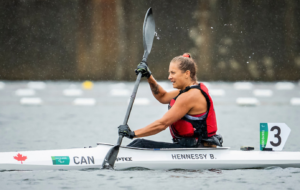 Further recommendations are likely to include asking organizations to look at their development strategies and ways they support athletes along the Para sport pathway, as many athletes reported feeling rushed to reach the highest levels of competition as quickly as possible, especially after a transfer. There’s discussion of an online platform to provide a forum for both peer-to-peer communication between athletes, but also more open collaboration between coaches and organizations. Funding will also be addressed within the recommendations. For example, the Athlete Assistance Program, which provides funding to athletes, does not currently allow athletes to be eligible for funding in more than one sport, which can be a barrier for multi-sport athletes.
Further recommendations are likely to include asking organizations to look at their development strategies and ways they support athletes along the Para sport pathway, as many athletes reported feeling rushed to reach the highest levels of competition as quickly as possible, especially after a transfer. There’s discussion of an online platform to provide a forum for both peer-to-peer communication between athletes, but also more open collaboration between coaches and organizations. Funding will also be addressed within the recommendations. For example, the Athlete Assistance Program, which provides funding to athletes, does not currently allow athletes to be eligible for funding in more than one sport, which can be a barrier for multi-sport athletes.
Overall, the goal is to pull conversation and policy surrounding transfer out of a “scarcity mindset” and towards a “robust mindset.” The latter is one where athletes feel supported and encouraged not only to try different sports, but also to chart a development pathway that feels physically and psychologically right for them.
Creative approaches to data collection can be useful for sport organizations to evaluate the effectiveness of youth programs. For example, movement-based methods use the structure or rules of a game to gather feedback from youth about their experience. They can also double as a program activity, helping to save time and keep kids on task. Read more in the SIRC blog.
Whether recognized formally or informally, athletes should occupy leadership roles to support a team’s functioning. Like some NHL teams, improving the number and effectiveness of athlete leaders can enhance team motivation, communication, cohesion and performance. Shared leadership among teammates can be an effective way to increase team dynamics and success.

